
「服裝,傳達著我們是誰,我們在生活中所扮演的角色。」用布料和服裝説故事的藝術家Merill Comeau如是說。
“Garments communicate who we are and the roles we play in life.” said Merill Comeau, a storyteller in fabric, crafting biography through garments.
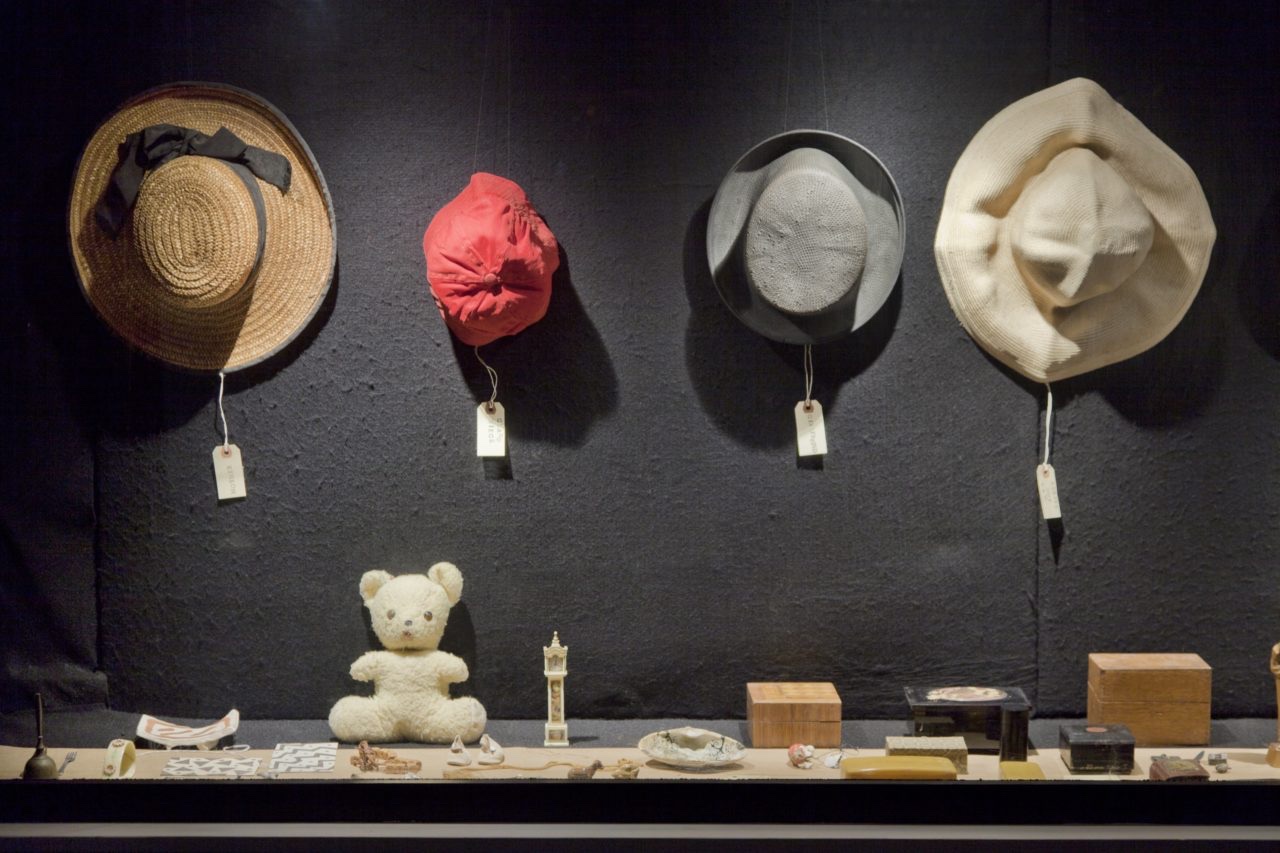
「服裝,傳達著我們是誰,我們在生活中所扮演的角色。」用布料和服裝説故事的藝術家Merill Comeau如是說。
“Garments communicate who we are and the roles we play in life.” said Merill Comeau, a storyteller in fabric, crafting biography through garments.
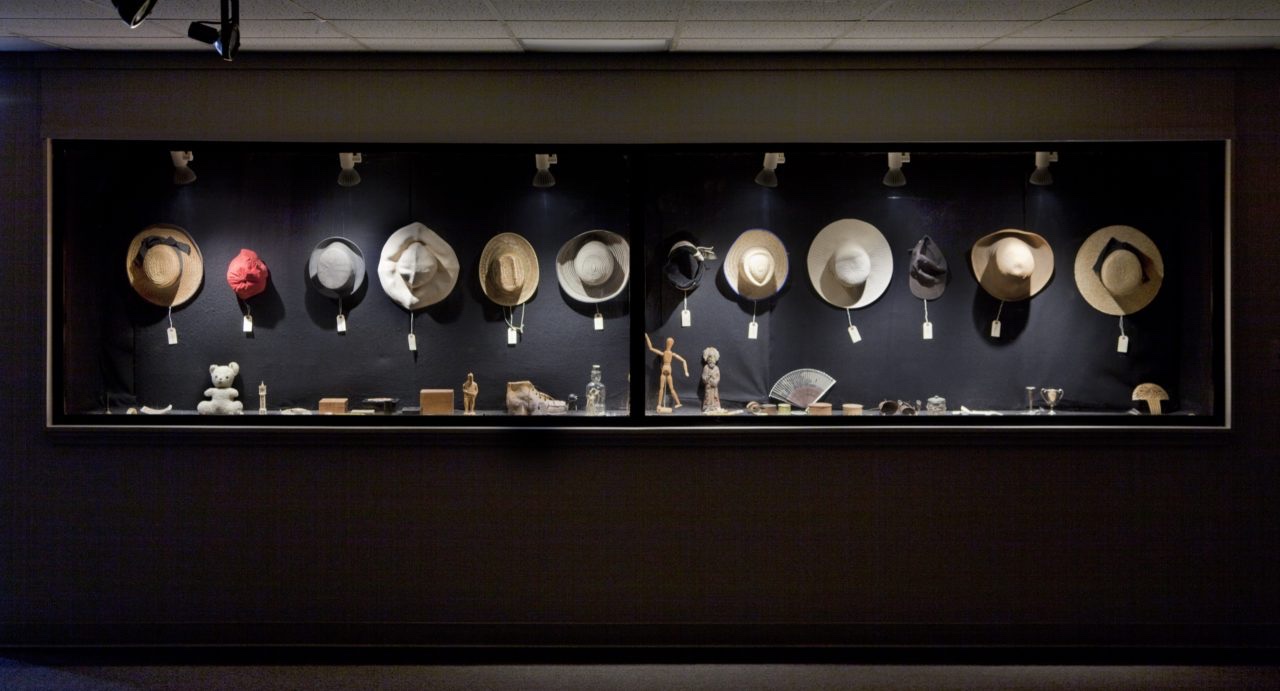
一字排開的帽子,是Merill從小到大所戴過的,每一頂都標誌著作為一位女性在家族關係中的權利、義務和經歷——如作為母親、岳母、姨媽、侄女、姊妹、女兒、孫侄女、孫女等等。
「我們曾戴過無數代表家族身份的帽子,其他女性也同時為我們戴上,多重的角色和不同的關係象徵,在視覺一致的夏季帽子中,隨着年紀、大小和個性而變化。」
The hats lined up are made up of the ones that Merill has worn over since childhood. Each is labeled with a female familial relationship she performs, experiences, or receives such as mother, mother-in-law, aunt, niece, sister, daughter, grandniece, granddaughter, etc.
“We wear so many hats as family women, and others wear those hats for us. The multitude of positions we embrace as women and relationships we navigate with each other is symbolized in the consistency of using only hats of summer but they are varied by age, size, and character.”
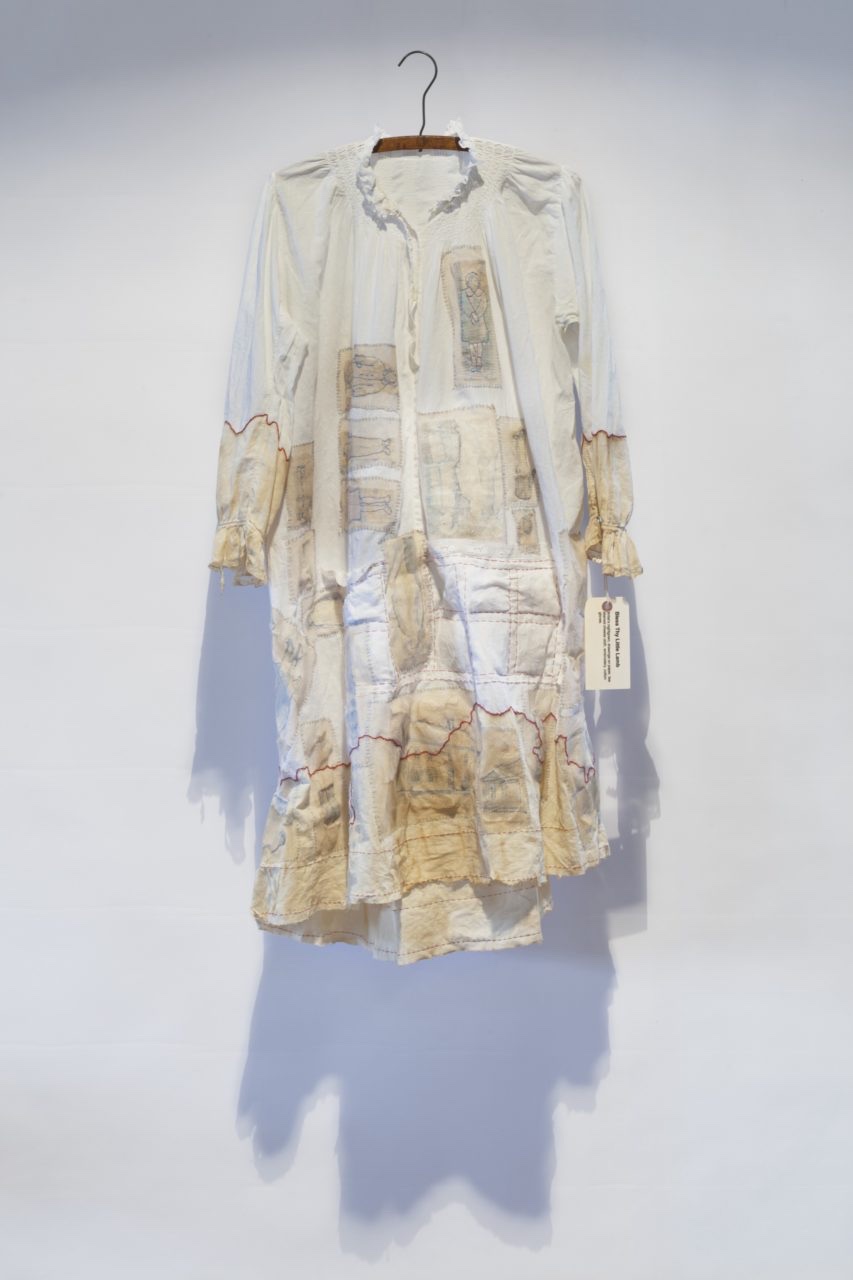
「小時候每晚睡覺前的家庭禱告,在單薄的睡衣上,幽靈般的藍線人像,靈感來自家族的舊照片,被刺繡在染了茶漬的夾棉上,身份都變得朦糊了;泥染了的袖口和衫腳暗示著難言之隱,而大部分睡衣的底部都被撕破了;即使回憶竭力透過人物線索向上攀爬,上半部依然留白,代表著一個凌亂過去的浮現。」
“It is part of a prayer my family said every night at bedtime during my childhood. On my fragile nightgown, ghost-like blue drawings inspired by old family photographs are stitched under patches of tea-stained cloth blurring specifics of identity. Discoloured cuffs and hem hint at a difficult slog through mud, much of the tainted gown has been torn from the bottom. Although memories climb the chemise through references to figures, the upper section remains white representing emergence from a messy past.”
「從2014年開始,我不間斷地把我的頭髮夾在已去世母親的襯衫裡,以探索社會對美的偏見和對女性衛生的期望。頭髮襯衫常在歷史上被使用,透過穿起時不舒服的感覺來提醒我們贖罪。小時候,每天早上媽媽常把我長期散亂的頭髮緊緊地編成辮子;長大了,她常要求我『梳好你的頭髮,塗點口紅,這樣你的丈夫才會想回家見你啊!』她在暗示我沒有吸引力,要多關注我的外表對留住丈夫十分重要。其實我的丈夫是無條件的愛著我,而且也覺得很荒謬,但我媽媽在生時常喋喋不休地告訴我,是她堅持要我梳好頭髮和塗點口紅而『挽救』了我的婚姻。」
“An ongoing project begun in 2014. I am lining my deceased mother’s shirt with my hair exploring societal biases about beauty and expectations of proper female hygiene. Hair shirts have been used throughout history to be worn with discomfort to remind us of to atone. When I was a child, my mother tightly braided my perpetually messy hair into submission every morning. As an adult, she would command me…’Comb your hair and put on some lipstick so your husband will want to come home to you!’ She was implying my failure to attract, that a positive assessment of my surface qualities was essential to my retaining my husband. My husband, who loves me without conditions, thought this was absurd. But while my mother was alive, she continually told me she ‘saved’ my marriage from ruin by insisting I comb hair and put on lipstick.”
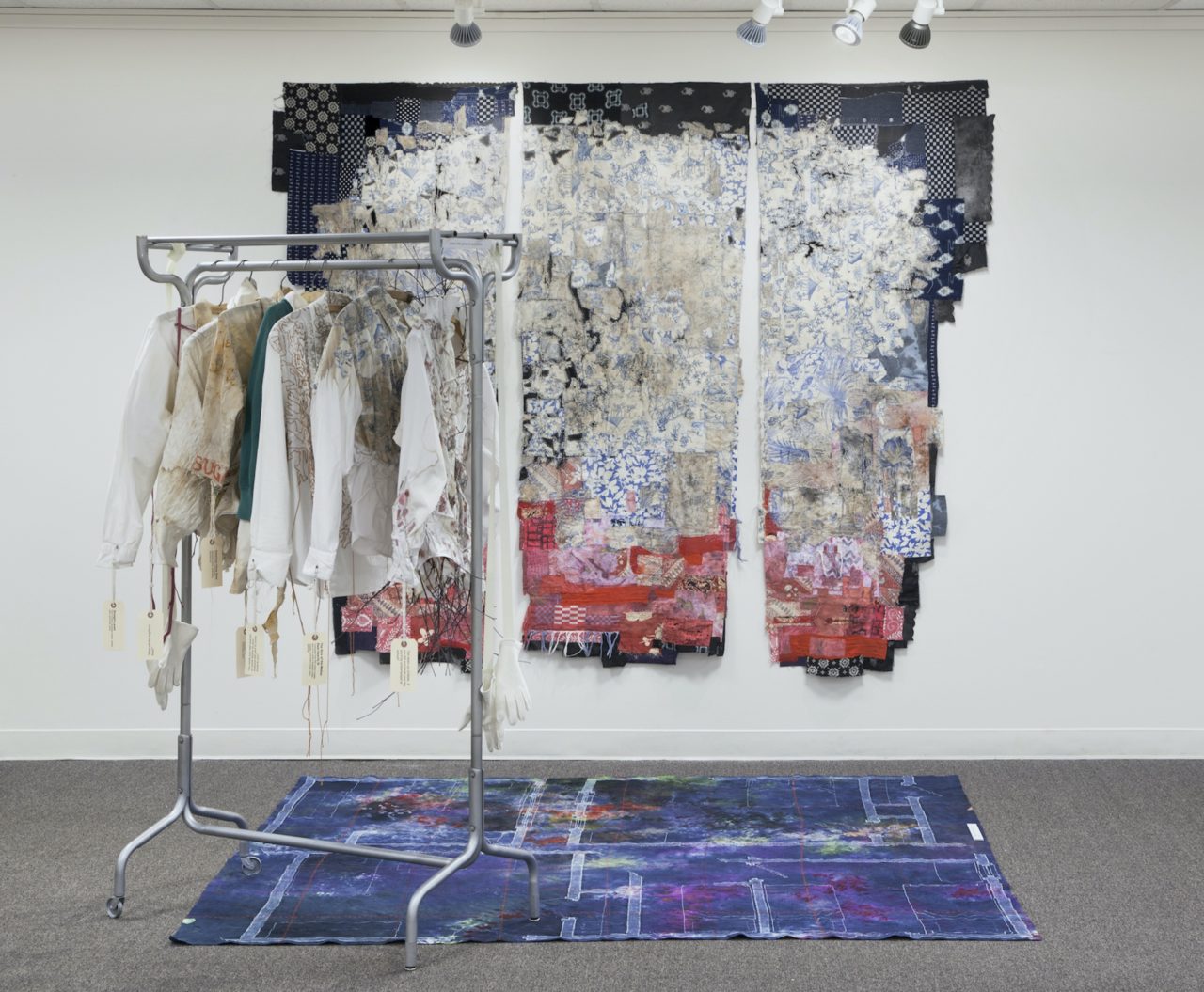
「母親的襯衫都被拆解、重整和裝飾,勾劃著那些曾對我説過如何成為一個『恰當』女人的言詞,我進入了過去和隨之而來的——偏見、局限性,以及我小時候所聽到的和今天常規所期望的對比。」
“The shirts of my deceased mother are deconstructed, reconstructed and embellished illustrating phrases spoken to me about how to be a ‘proper’ woman. I reach into the past and its accompanying prejudices and strictures and contrast what I heard as a girl with the norms and expectations of today.”
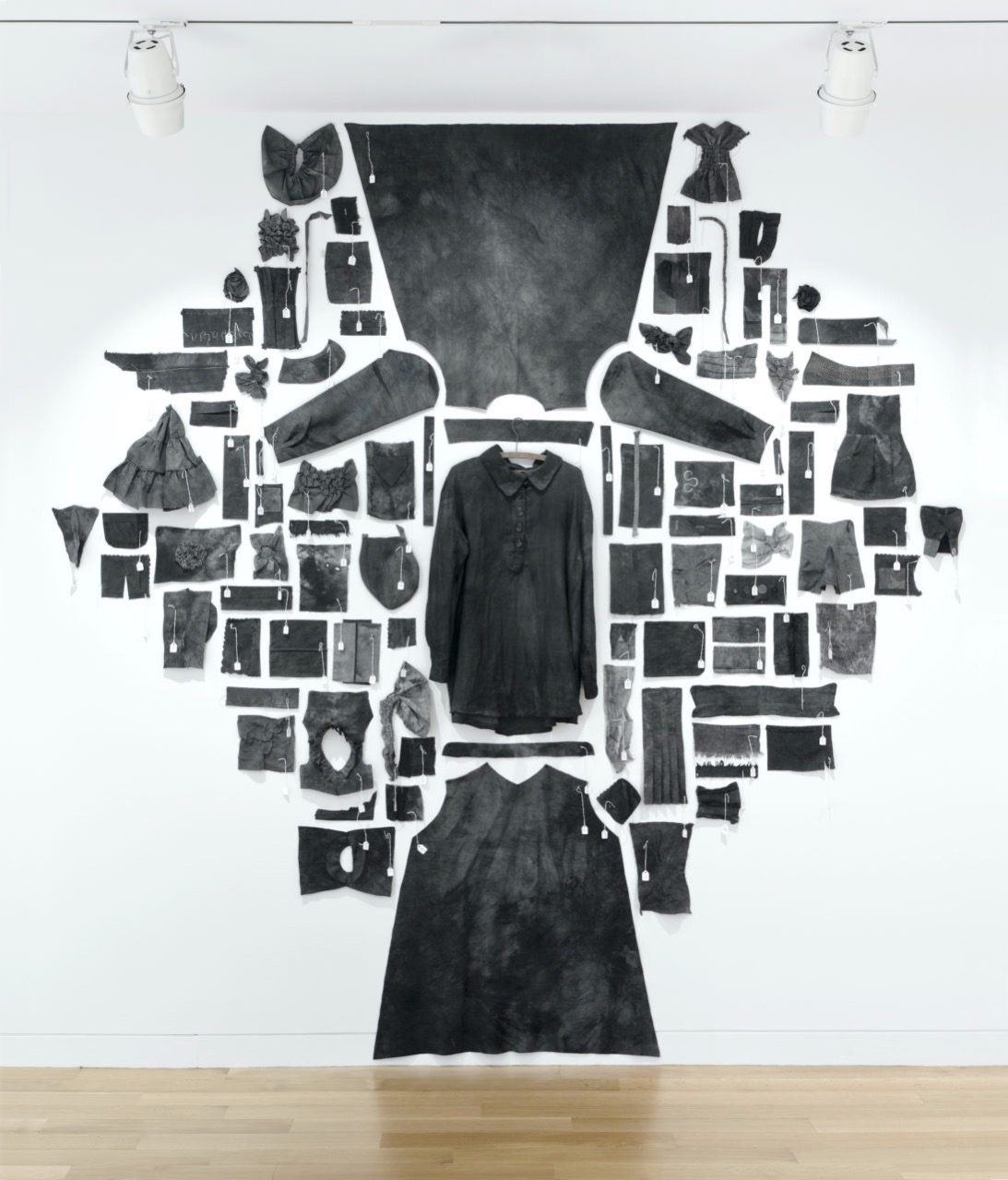
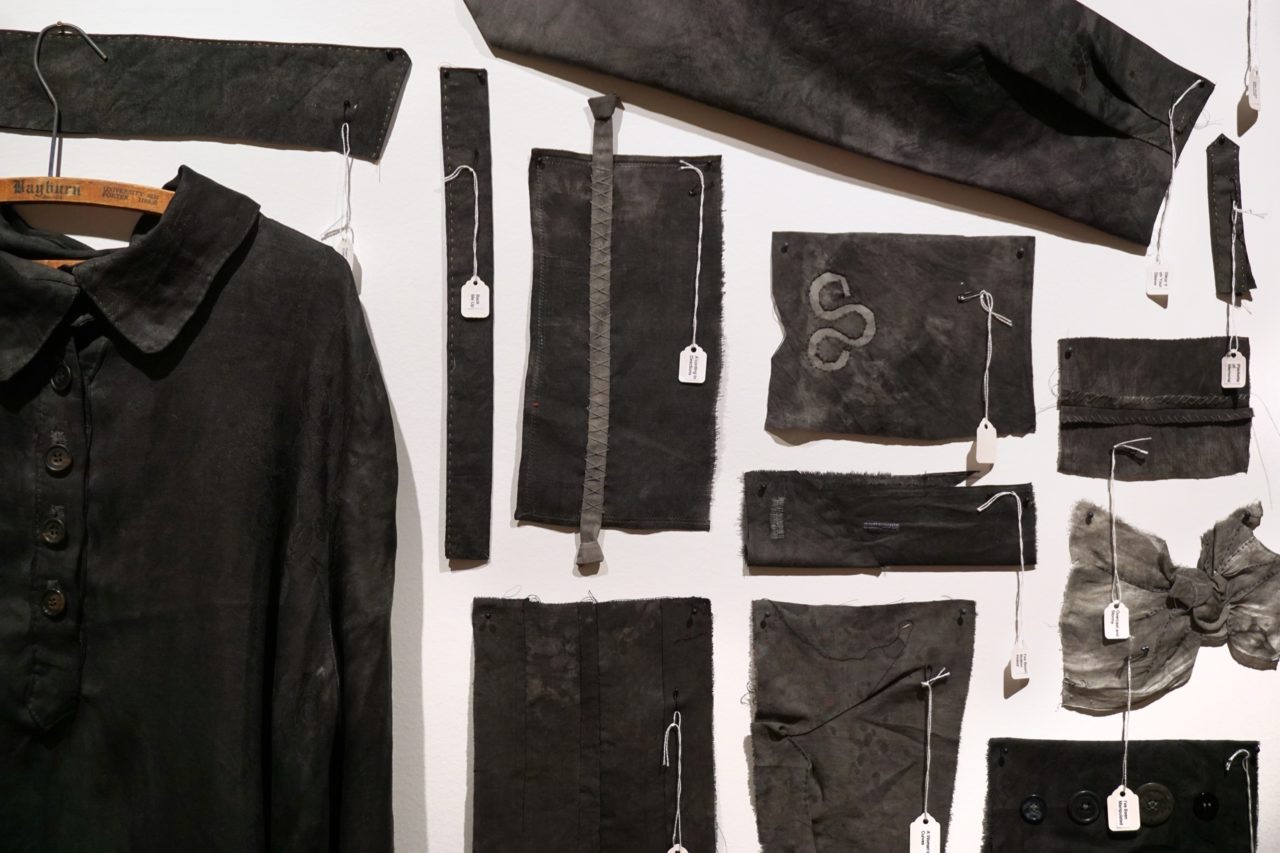
Photo courtesy of the Danforth Art Museum Framingham State University
作品現在已被弗雷明漢州立大學丹佛斯藝術博物館收藏。
The work is now in the collection of the Danforth Museum of Art, Framingham State University.
布料手塗上哀悼的顏色,正向歷史和當代服裝製作的工人致敬,同時也在探討衣物的結構,以及現在我們和衣物製作的分離。Merill用了9年時間,經歷了無數縫紉技巧的錯敗和磨鍊,創作了這組裝置藝術。一直以來,針黹技巧是女性必然的工作,是有用和具生產力的,衣服製作更是日常必需的工作,然而這些Women’s Work (女性的作品) 都是無名無姓,意味著女性一直留下來的東西——都常被用作訴說被忽視了的歷史。
在Merill的藝術中,她解構服裝並重構元素來創作新的布藝作品,拿著拆線刀拆解別人的作品。「回想起2012年在Hambidge藝術與科學中心居住期間,我解構了一件古董絲綢上衣,我意識到當我剪開時,我便破壞了製造者縝密的一針一線,我深深被藏在衣服內製造者和擁有者 (不一定是同一個人) 的記憶所感動。」
「一根針能充當編織身份的工具,是一枝筆所不能的。」
The fabric is hand-painted in the colour of mourning, honours women throughout history working in the textile industry. Additionally, this work explores our current disconnection to the manufacture of our clothing. Building this installation progressed over nine years, Merill experienced countless failures and trials of sewing skills. Historically, skill in sewing was a necessity for working women. Learning to sew was deemed useful and productive, the creation of garments an essential task. The anonymous nature of “women’s work” means that the objects women left behind are often what are used to tell overlooked histories.
In Merill’s art, she deconstructs clothing and reconstructs elements to create new textiles. Using her seam ripper, she undoes another’s work. “While on residency at the Hambidge Center for Art and Science in 2012, I deconstructed an antique silk bodice — I recognized that, as I snipped, I destroyed the maker’s meticulous hand stitches. Moved by the memory inherent in the bodice (of the maker and the owner – not necessarily the same person)”
“The needle served as the tool for crafting identity in a way that the pen could not.”
Merill從小就聽著『不要浪費』的箴言,父母在大蕭條中倖免於難,物盡其用是家中的常態。 她早已學會了修改轉贈而來的衣物,創作出「新衣服」。 而且在年輕時,她已學習回收玻璃,塑料和剩食堆肥,以支持環境的健康。
「今天,世界的資源不公和全球化已成為了人們關注的問題。」她慨嘆著說。「我有一個朋友圈子,有孩子們從衣物中長大了,也有年長親戚離世後留下放滿壁櫥的衣服,都成了我創作藝術的資源。 這些來源因穿著而磨損,因進餐而沾污,都承載著他們的生活記憶;織物圖案和服裝設計反映了時代、品味,富裕程度,功能、時尚或社會地位。 」
Growing up hearing the adage “waste not, want not.”. Merill’s parents survived the Great Depression and salvaging materials for reuse was the norm in her family home. She learned to alter hand-me-downs to create “new.” clothes. During her teens and early adulthood, she learned to recycle glass and plastic and compost table scraps as an act of supporting a healthy environment. “And today, worldwide inequitable use of resources and globalization are concerns.” she lamented. “I had a community of friends with children growing out of their outfits and elderly relatives dying leaving behind closets full of clothing – ample sources for artmaking. With their frayed edges from wear and stains from meals shared, these sources carry memory of lives lived. Fabric patterns and garment designs reflect time periods, taste, affluence, function, fashion, or social status.”
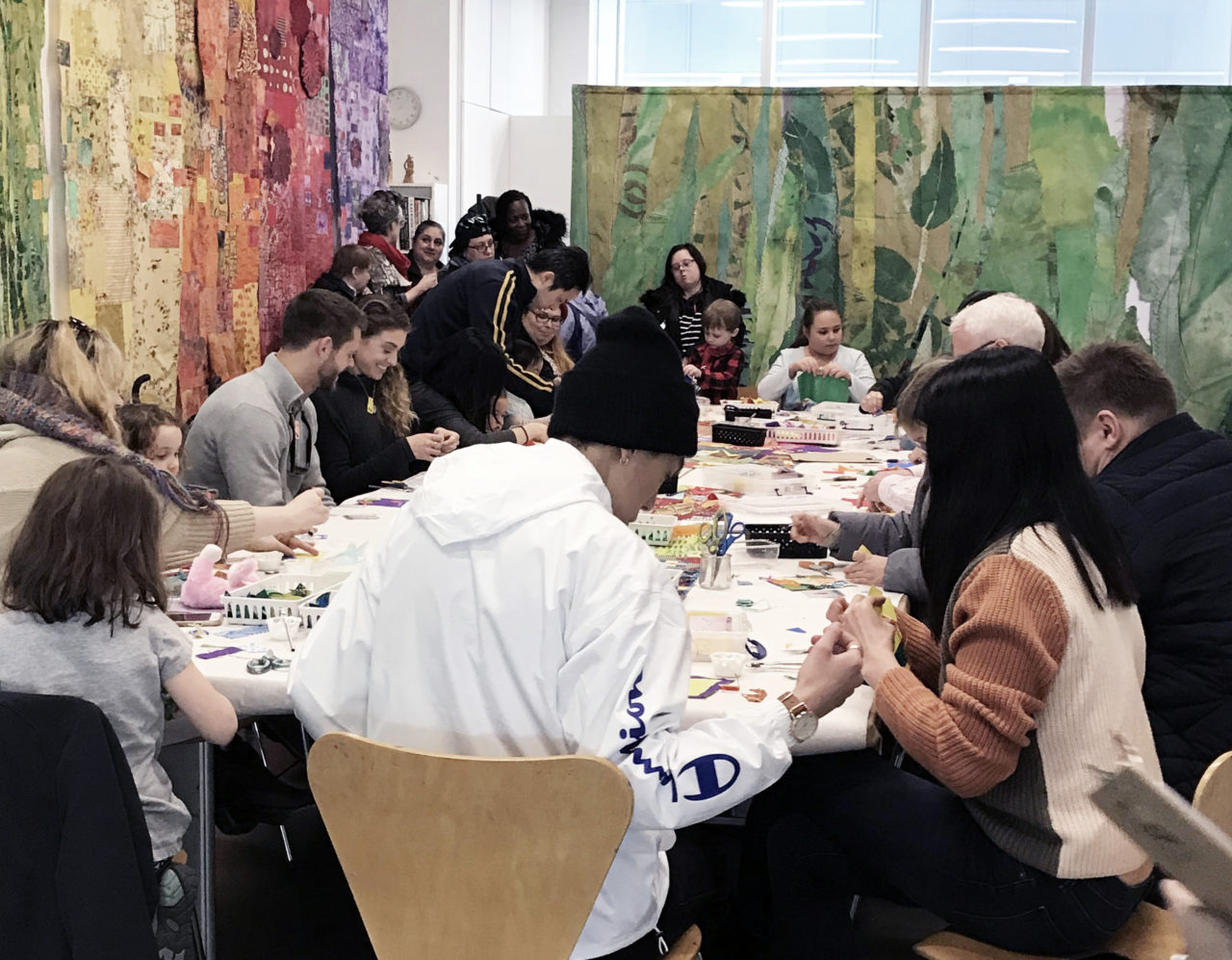
Photography by the ICA’s photographer, Cassandra Rodriguez.
擁有社會理論和政治經濟學為本科學位的Merill,學習心理學、社會學、婦女歷史和左派經濟學,從中學會觀察、分析,理解和提出關於人類行為的理論。作為一位一神論主義者,她相信所有人都擁有內在價值和尊嚴。 她會運用一系列的練習培養反思和分享,引導人們表達自己,整理繁複的個人表達方式,來認知大家的共同性和感受到在一起的溫度。
她在工作坊裡與兒童、成人,混合年齡以及不同宗教、背景和慾望的人一起,探索大家的共通與不同。例如以教學藝術家身份,與居住在安全治療中心的馬薩諸塞州法院中服刑青年一起工作,幫助青年服務部展現年輕的藝術聲音。「我的做法是針對創傷的,並利用視覺表達來敘述故事,傳播知識並定義價值觀。這些工作和我的教育背景都直接對我作品的概念基礎很有幫助。」至於 Threads of Connection 的活動,很可惜在進行了6週後就停止了!一切就定格在博物館裡,至今不能進入,差不多一年了!它的將來仍然未能確定。
Merill with an undergraduate degree in social theory and political economy studied a wide range of subjects such as psychology, sociology, women’s history, and leftist economics. She learned to observe, analyze, understand, and posit theories about human behaviour. As a Unitarian Universalist, she believes in the inherent worth and dignity of all people. She employs a series of exercises she developed to foster reflection and sharing and to guide people to express themselves and to combine diverse individual expressions in ways that reinforce our perception of commonalities and feelings of togetherness.
She teaches workshops and works with groups of children, adults, mixed ages and people of different religions, backgrounds, and desires in which they investigate individual differences and similarities. For example, she facilitates the emergence of young artistic voices as a teaching artist for the Department of Youth Services working with youth-serving sentences in the Massachusetts court system residing in secure treatment centres. “My practice is trauma-informed and uses visual expression to tell stories, transmit knowledge, and define values. This work and my educational background directly contribute to the conceptual underpinnings of my work.” Unfortunately, as for the activity, Threads of Connection, closed 6 weeks into its run. It is still at the museum, inaccessible today – almost a year later! Its future is uncertain.
「對我來說,縫紉是建構和裝飾、工藝和藝術。 我喜歡用縫紉機的機械工具和講求專注安靜的手工縫製。 工作時,我感到自己與悠久歷史和廣泛的文化聯繫在一起,並引領紗線來創造有用的東西,表達美感。」Merill Comeau相信我們都有能力以視覺溝通,而那些視覺表達正讓我們説出不能用言語來表達的話。
神奇地,在地球另一角落找到一位很欣賞的藝術家,也正在做著 Tales of Time in Textile (織物裡關於時間的故事), 相信衣物能帶回時間經歷和療癒心靈。
“Stitching is construction and embellishment, craft and art. I love working with the mechanical tool of a sewing machine, and the focus and quietude required for hand stitching. As I work, I feel connected to a very long history and wide breadth of cultures creating and manipulating fibres to create useful items and to express beauty.” Merill Comeau believes that we all have the capacity to communicate visually and that visual expression allows us to say things we cannot express in words.
It’s amazing to find someone I admire in another corner of the world, who is also doing Tales of Time in Textile, and believe that clothes can bring back time, experience and heal our souls.